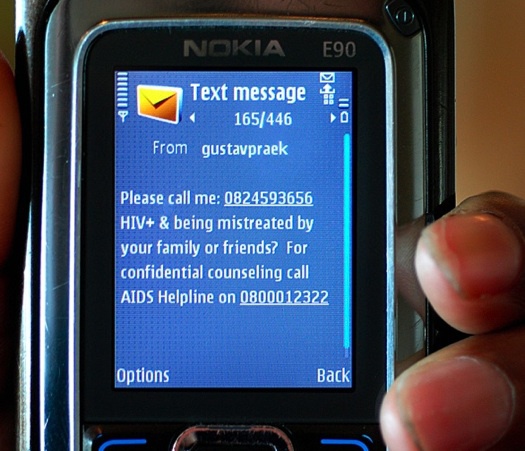
Text messages are the medium by which Project M seeks to accelerate testing for HIV/AIDS in South Africa. Photo courtesy PopTech
This case study about Project Masiluleke describes in detail the design process used by a collaborative effort to address HIV/AIDS in South Africa. Organizers of the PopTech Conference, Frog Design and South Africa’s Praekelt Foundation worked together with iTEACH in KwaZulu-Natal, South Africa, to develop new approaches and game-changing innovations. It is the third in a series of cases focusing on design and social innovation, created by the Yale School of Management in collaboration with Winterhouse Institute, funded by the Rockefeller Foundation.
When iTEACH, an education and outreach team from Edendale Hospital in KwaZulu-Natal, South Africa, presented their HIV/AIDS and TB prevention and treatment programs at the PopTech conference in 2006, PopTech organizers saw an opportunity to apply the conference’s vision: accelerating social innovation through technology. The result was Project Masiluleke. (Masiluleke is a Zulu word meaning “wise council” or “helping hand.”)
Over the next two years, the partners in Project Masiluleke — often referred to as Project M —came together to address HIV/AIDS in South Africa. The group decided to focus on HIV testing, rather than on treatment or prevention, and worked to integrate their disparate interests and skills to develop new approaches to this major health problem.
Case Background
The challenges facing Project Masiluleke in 2006 were daunting. Regional HIV/AIDS infection rates were estimated at 30 to 40 percent. Efforts to raise awareness were challenging in a culture in which the disease was strongly stigmatized and many were reluctant to come forward for testing.
The government’s antipathy to scientific explanations of AIDS causation and medical treatments complicated efforts to make testing and treatment acceptable. The collaboration required close interactions between healthcare professionals from iTEACH in KwaZulu-Natal, designers at Frog Design in San Francisco and New York, technology experts at the Praekelt Foundation in Johannesburg, and facilitators from the PopTech conference in Camden, Maine. The participants had to bridge geographic and cultural barriers and overcome the inevitable missteps.
The case study details the development of two innovations that combined technology and social need: a mobile phone texting system to encourage users to get more information on HIV/AIDS and a user-friendly self-test kit with mobile phone support. These approaches were innovative, creating challenges for the Project M team. No one knew how text messages on mobile phones would influence behavior, or whether consumer-friendly testing material could guide untrained individuals to perform medical tests and seek appropriate follow up.
Case Resources
The case study uses text, video interviews and slideshows to describe the design development. Students can follow the succession of challenges the team faced and the scope and importance of the problems addressed. Development of the case was overseen by Rodrigo Canales, assistant professor of organizational behavior at the Yale School of Management and Jean W. Rosenthal, project editor at the Yale School of Management’s Case Study Research Department, with videos by Jeffrey Levick, multimedia producer at Case Study Research Department.
The online case study includes text and multimedia elements, including:
• Over 30 video clips featuring interviews with participants at PopTech, Frog Design and the Praekelt Foundation.
• 16 slideshows of detailed design development – drawings, photographs, packaging alternatives, prototypes and user testing.
• Numerous links and photographs providing context and additional details of design development.
• Two data sets for numerical analysis: (1) two years of responses to mobile phone messages for correlation analysis; (2) an explanation and exercise in using Bayesian analysis to understand medical screening.
Teaching Objectives
The case study asks students to consider Project M’s process and outcomes. It details the development of concepts and the design process, from fieldwork through prototypes; but the end result remains open-ended as Frog continues to work on designs for an HIV self-test kit and other participants consider how best to use cell phone “please call me” messages for social ends.
Students can analyze project success and consider alternatives in multiple areas, such as:
• Recognizing participants’ goals and skills, and integrating them into the group’s goals.
• Working with large and complex societal needs, determining the best place to start to facilitate change.
• Finding ways for the diverse group to create and test innovative approaches quickly, in spite of cultural, geographic and technological barriers.
• Incorporating aspects of the design process that were particularly suited to addressing the challenges in South Africa.
• Addressing the inevitable missteps and responding to failure.
• Measuring success.
Additional Discussion Topics
Innovative products. The Project M team proposed and developed two game-changing products, moving rapidly from concept to prototype. How did they do it?
Adapting technology to social enterprise. The team's initial observations suggested that mobile phones could be effective in the at-risk population. In the first phase, the team tracked the mobile text messages that provided information about HIV/AIDS using various themes and languages. In the second phase, the team used field-testing to judge the effectiveness of user-friendly directions with mobile phone support for individuals taking HIV screening tests in private. Student analysis can address the question: how effective were the programs?
Working across barriers. How did the Project M participants bring their varied backgrounds and experiences into a working collaboration that met individual and group goals?
Engaging users in the design process. Developing a self-test kit for HIV/AIDS in South Africa required a design that would work across individual, community and national differences. How did the designers engage the knowledge and expertise of a culture far from their own?
Learning from failure. Project M’s development of the self-test kit used interactive research, quick prototyping and rapid iterations to incorporate the end-user experience as it developed products. How did the acceptance and challenge of design “failures” move the process forward?
